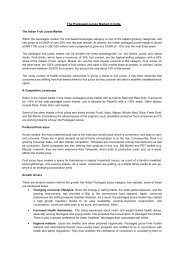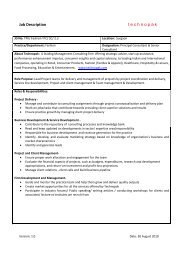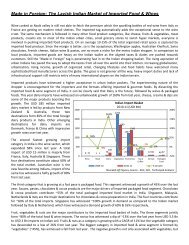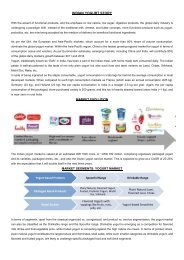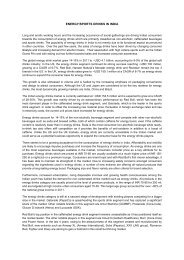a quarterly report by - Technopak
a quarterly report by - Technopak
a quarterly report by - Technopak
You also want an ePaper? Increase the reach of your titles
YUMPU automatically turns print PDFs into web optimized ePapers that Google loves.
Bangladesh Offers Low Cost Production.<br />
•The<br />
cumulative FDI in Bangladesh from 1998 to 2008 amounts to UD$ 6.5 Bn<br />
•16%<br />
of FDI is in the textile sector, amounting to ~US$ 1 Bn<br />
•75%<br />
of the country’s export earnings come from textiles and apparel<br />
perspective<br />
a quar terly repor t <strong>by</strong><br />
•Readymade<br />
garment exports increased from US$ 643 Mn in 1990, to US$ 12 Bn in 2008<br />
•This<br />
has been possible due to the proactive role of the government and trade associations<br />
India’s case is similar to that of China. India is in a unique position to offer both a substantial and fast<br />
growing domestic market and a country rich of resources required for low cost production. In sum, investing<br />
companies have been motivated to enter into collaborations with host country firms due to increasing gains<br />
that can be made <strong>by</strong> producing brands in the host country and selling them into the host country market.<br />
Host country companies have been motivated <strong>by</strong> the scope for gaining technical and marketing expertise<br />
from foreign partners.<br />
FDI in India: Current Scenario<br />
Due to India’s recent liberalization of its foreign investment regulations, the country has become one of the<br />
fastest growing destinations for FDI inflows. India offers many advantages for foreign investors like strong<br />
economic growth leading to increased buying power <strong>by</strong> the middle class, low wages, and an educated<br />
work force. India’s Special Economic Zones (SEZs) attract foreign investment <strong>by</strong> providing tax incentives,<br />
assistance with bureaucratic and administrative problems, and access to reliable infrastructure.<br />
Indian economy is growing at the rate of in excess of 6% per annum since last 10 years. Even in times<br />
of recession / slowdown in most of the developed economies, India is expected to maintain this level of<br />
growth. From 1990 to 2007, India’s GDP has grown at an annualized rate of 8% which is second only to<br />
China among present trillion dollar economies.<br />
Exhibit 3<br />
US$ Mn<br />
30000<br />
25000<br />
20000<br />
15000<br />
10000<br />
5000<br />
0<br />
1991-1992<br />
(Aug-March)<br />
1992-1993<br />
1993-1994<br />
1994-1995<br />
1995-1996<br />
FDI Inflows in India (1991 to present)<br />
1996-1997<br />
1997-1998<br />
1998-1999<br />
1999-2000<br />
From August 1991 to March 2009, India has attracted a total FDI of US$ 106 Bn, of which approximately<br />
US$ 90 Bn was invested during Apr ’00 to Mar ’09.<br />
Extending its liberalization policies to other industries, India also raised the level of foreign equity ownership<br />
permitted in civil aviation, refineries, some mineral mining, construction, industrial parks and commodity<br />
exchanges in January 2008.<br />
In the textile and apparel sector, 100% FDI is allowed under the automatic route. FDI in sectors to the extent<br />
permitted under automatic route does not require any prior approval either <strong>by</strong> the Government of India<br />
2000-2001<br />
2001-2002<br />
2002-2003<br />
2003-2004<br />
2004-2005<br />
2005-2006<br />
2006-2007<br />
2007-2008<br />
Volume 02 / 2009<br />
2008-2009<br />
| Volume 02<br />
FDI : A Catalyst for Growth of the Textile & Apparel Industry |<br />
34



